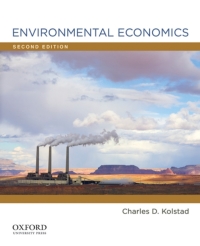Consider a situation involving Finch's Footwear and Millie's Muffins. Finch's Footwear produces shoes ((S)) at a cost
Question:
Consider a situation involving Finch's Footwear and Millie's Muffins. Finch's Footwear produces shoes \((S)\) at a cost \(C_{s}(S)=S^{2}+8\) and the Millie's Muffins produces baked goods (B) at a cost of \(C_{\mathrm{B}}(B, S)=B^{2}+B S+4\). There are fixed costs but no sunk costs. Note that costs for the Millie's Muffins depend on output of the shoe company, because of the pollution associated with making shoes (more money has to be spent by Millie to keep things clean). The price of baked goods, \(p_{B}\), is fixed at 10 .
a. Calculate how much footwear and muffins will be produced if the two firms merge, assuming profit maximizing behavior. Do this for two different prices of shoes: \(p_{\mathrm{s}}=8\) and \(p_{\mathrm{s}}=14\).
b. If Finch's Footwear has rights to pollute, how much baked goods and footwear will be produced at the same two prices for shoes ( \(p_{\mathrm{s}}=8\) and \(\left.p_{\mathrm{s}}=14\right)\) ?
c. If Millie's Muffins has a right to clean air, how much baked goods and footwear will be produced, and what if anything will Millie receive for compensation? Use the same two prices for Finch's output ( \(p_{\mathrm{s}}=8\) and \(p_{\mathrm{s}}=14\) ).
d. Why is the foregoing consistent or inconsistent with the Coase Theorem?
Step by Step Answer:






